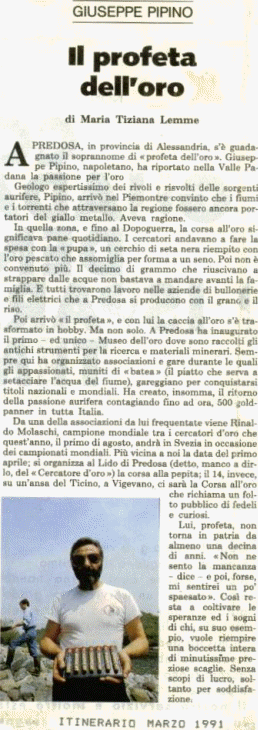
Giuseppe PIPINO was born in Neaples in August 1942, having Neapolitan father and Romagna’s mother. He leaved in many Italian cities, prevalently in Genoa and Milan. Actually he leaves in Roccagrimalda’s countryside, Alessandria province, Piedmont.
In the year 1960 he gratuated Commerce Accountant, to the Salvator Rosa Instituite, Neaples, and starts to work in Romagna and in Liguria. In that last Region began his mineralogical interest.
In the year 1971 he gratuated Scientific Maturity to the Enrico Fermi high school, Genoa.
In the 1975 he gratuated Geological Sciences to the Geological, Petrographical, Mineralogical and Geochemical Institutes of the Milano University, discussing a thesis about the Ovada’s country Gold Mineralisations, in the ophiolite Voltri Group. Successively he extended his studies to all the Group, first with Italian Researches Council, then as consultant of the NORANDA, a Canadian larger mining companies.
In the year 1982 he was registered in the ONU International Roster as an expert on Geological and Geochemical Exploration, and carried out exploration on the Arabian Emirates ophiolite mine ralisations.
ralisations.
From the 1977 to the 1991 years he was technician and director of the company “TEKNOGEO, Indagini Geologiche e Minerarie”, and carried out mining exploration in many Italian countries and abroad, in partnership with the major international mining companies. In particularly he applied of exploration and exploitation of gold placers in many parts of the world.
Between the years 1984 and 1986 he discovered the first epithermal gold mineralization (invisible gold) in the Tuscany and Latium regions, then, as consultant of the AGIP MINIERE Company, gave information to find same mineralization in Sardinia. Also he discovered and point out to the Piedmont Archaeological Superintendence extensive tailings of Roman alluvial gold mines (aurifodinae) in the regions of Ovada, Ivrea and Vercelli.
From the years 1980 to 1995 he was editor of the “Rivista Mineralogica Italiana” and cooperated with the Natural History Museum of Turin for the compilation of the “Inventario Mineralogico Piemontese”. He is the Author of many papers about mineralogy, hydrogeology, mineral deposits and mining history of Italy in general, of the Alps, Po Plane and Ligury territories in particular.
To him we must the actual knowledge on location, nature and history of Italian gold: when he start his studies, the same presence of gold in Italy was undervalued or explicitly refused by academicians also, in spite of historical records. To him we must the last years development of the goldpanning hobby in Italy: in fact, to the end of the 1970’s this hobby was experienced only by a ten passionate along the river between Milan and Turin, but in short time notably increased, thanks to the events organized by him. He organized the firsts public events in Ovada,s territory starting from the year 1981, for the aim to demonstrate to the sceptical the gold real presence and its recovery possibilities; in Ovada he organized the 1985 World Goldpanning Championships to which take part some hundred passionate, in more part foreign, and the event resonance resolutely contributed to make known the Italian gold possibilities.
During his surveys he had care to divulge every testimonies on the gold presence and its recovery methods in Italy, activity that in the past had an important but unknown economic and social importance, as he always attempted to demonstrate. In the year 1981 he established a fist museum nucleus in Casalcermelli, Alessandria Province, with the materials collected during his prospections and historical surveys on the old Gorzente valley gold mines and Orba plane gold placers; then the development of his surveys in other parts of Italy permitted to collect many other testimonies and to establish, in the year 1987, the Italian Gold History Museum, all with his own fees and without any public contributions.


